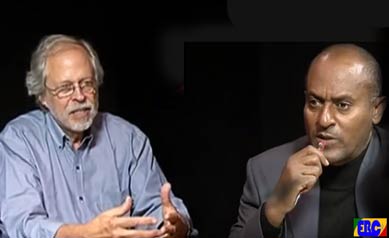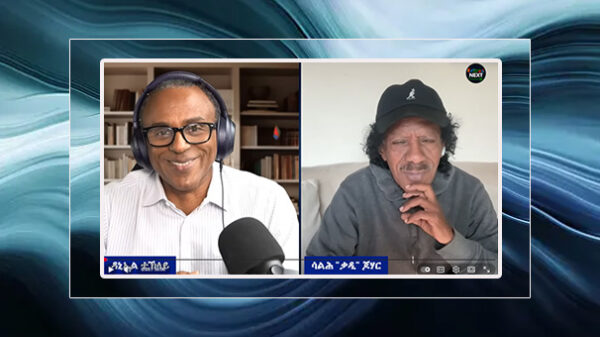Cabbages and Kings and Why the Sea is Boiling Hot – IX
“The time has come,” the Walrus said – “To talk of many things: Of shoes and ships and sealing wax – Of cabbages and kings And why the sea is boiling hot – And whether pigs have wings” Through the Looking Glass by Lewis Carroll
In the last two issues of this series it was established that Arabic was part and parcel of the Eritrean culture. It was confirmed to be the second of three working languages of Eritrea by an authority no less than the Ministry of Information of the State of Eritrea. Arabic is also emblazoned on the three most important national icons: the ID, the passport and the coat of arms of Eritrea. The act of designating official language(s) is nothing but a confirmation of the most popular language(s) the people of a country use to communicate with each other and conduct business. Those few Highlanders who refuse the reality of Arabic are either obdurate chauvinists who entertain the misguided concept that Eritrea is a Christian country – a fairy tale Ethiopia adhered to for centuries but gave up decades ago – or alarmists of jihad naïve enough to believe denying Muslims their preferred language will stave off the threat.
It is unfortunate that the PFDJ and the constitution have left the question of official language in limbo while at the same time acknowledging its working languages – a state of affairs which has given cause to so much literary and coffee shop squabbling over a de facto official language. As the Tigrinya saying goes: kimble belle’mber aytekhaw’en (It tumbled but did not spill over). So far as this series is concerned the case rests until the appropriate democratic setting is created to inaugurate our working languages by an amendment to the Eritrean Constitution.
Now back to comments made on another component of the suggested set of collective mindset.
The Land Fetish
Of the limited comments on this subject, one is from a notorious ghost who hounds the Abyssinian websites and never fails to give the “erring” contributors a smarting comment if they happen to stray from his train of thoughts and what he holds as truth. This time he objected to what he calls my “… evasive way of covering the land issue which is certainly INTENTIONAL.” (His capitalization)
Of course my intention is to rid ourselves of damaging myths, beliefs and fetishes which have been and continue to be sources of discord and strife in our society, and I am engaged with the land issue head-on with a perspective. I am advocating for a forward looking collective mindset to encumber the so called “current” crisis which has actually been with us for centuries – land having been the primary cause for so many feuds and pitched conflicts in our history. The past distorted mindset on land has resulted in a deplorable system with extensive damage to the land itself and the environment as a whole.
Some scholars have advocated that the customary tenure system had built-in systems to safe guard the eco-system of plant life and soil fertility. May be so if one is to stretch one’s imagination and visualize romantically the virtues of our fore fathers. But the present day vivid reality of the landscape is a telling truth to the generally accepted conclusion that the traditional land tenure system has lent itself to severe environmental degradation, depletion of flora and fauna and declining agricultural productivity. During the last century alone the forested land was reduced from 30% to 13.5%[1][1]. The gross neglect to protection and maintenance of forestry by the Italian colonizers and the collateral damages of the prolonged war of liberation have contributed to this sad trend, but the state of affairs cannot be rectified so long as the toxic land tenure system is allowed to endure.
Studies carried out indicate the land tenure system itself is fraught with so much terminology over the definition and etymology of some of which there is discrepancy among such experts as Nadel, Kibreab, Negash, Joirman, Gebremehin[2][2], Janet Gruber[3][3], Luca Castellani[4][4], etc… Their works overwhelm you with a confounding array of terms such as: medri, risti, gulti, shum-gulti, tsilmi, diesa, shekh’na, rim, meriet werki, tisha, grat fereka, krai, enda, deki, ristenya, gebar, kursi, dar, and procedures involving shumegna, shemgelti, warieda, ghelafo, acquaro, sedbi…
None of these experts claim that an exhaustive study has been carried out, suggesting that the substance and application of the tenure system is tenuous. Nearly all of them are agreed that: 1) the traditional land tenure system deprives women, blacksmiths and other tradesmen, and in certain areas Muslims, of any land entitlement; 2) “the history of Eritrea is one of constant migration – [m]igrations from without and migrations from place to place within the territory.” and hence, “… the complexity of ethnic membership, religious adherence and linguistic identification,” which encumbers the evolution of uniformly consistent land tenure systems; 3) the tenure system has been tampered with by: Ethiopia in the pre-colonial era; Italy, particularly in the declaration of domaniali (crown lands) and abetting of the diesa (communal) land holding; and again, Ethiopia at the dissolution of the Federation and the Dergue land decree of 1975; 4) resettlement of refugees after independence and internally displaced people during the 1998-2000 war with Ethiopia; and 5) PFDJ’s land proclamation of 1995, the last two items of which have brought the old system into disarray without so much affecting the negative element of the fetish mindset.
What drove the Italians to promote the diesa at the expense of the other categories is the endless litigation over land rights often resulting in violent conflicts and disruption of peace and stability. This implies that the other systems have instead of streamlining relations between people regarding land had instead been the cause of viral squabble.
Although the land tenure system in the Lowlands is not researched as much, it is deemed that grazing lands are communally administered – with pastoralists leading a semi-nomadic life. Along with the diesa prominent in the Highlands communal ownership is therefore the dominant category of rural land ownership. In this respect the following is the conclusion arrived at by the FAO sponsored study.
The traditional land system has been inadequate in promoting sound environmental management practices and sustainable agricultural development. This system discouraged permanent improvement of land and encouraged the pursuit of short-term gains. This led to severe resource depletion, including almost deforestation of the country.[5][5]
The same report states that although there was a sharp increase in population of livestock in the first two years of independence, there was a decline in growth rates in the 1992-2000 periods. At the root of it all is the excessive attachment to land – the land fetish – an overly emotional mindset which led to a detrimental communal land holding systems and other archaic categories.
As I have reassured another commentator, my effort is to direct the collective mindset to accept subjecting land to the capitalist free market system. Although capitalism in its crudest definition no longer exists, its humanized form has proven itself to be the preferred driving force in almost all economies. Former giant socialist nations have turned their back on communism, abandoned collectivization and communal land tenure, and brought their economies to unparalleled heights in their history. They have now become economic power houses to be reckoned with by their counterparts in the free world. New applications of capitalism such as social entrepreneurship are doing wonders in developing countries in which capitalists invest in such enterprises as micro lending to the poor and making modest incomes from the venture.
The current stupendous price being paid for a 2-room villa in Asmara is not a machination of the delala (broker) as the supporters of the regime want us to believe. Neither is it for the mass of bricks and cement that went into it. It is for the land on which it stands, now the property of the Government, who has instituted tortuous rules and regulations including foreign exchange requirements inhibiting access, sale and transfer of immovable property thereby perpetuating obtuse distortion of the economy. Unless we categorize land as a capital commodity to be offered in the free market the chances of our people emerging from poverty and want are very dim.
Now let me say a word about grazing lands and the impending danger to the pastoral way of life often decried by some researchers. Don’t listen to the academics with a bleeding heart for the doomed pastoral way of life. It is a life they wouldn’t wish for themselves and their children. It is a life wasted in nomadic subsistence and is in no way amenable to human development.
I once met a Fulani in West Africa; the Fulani are a light skinned ethnic group spread over West Africa who claim their ancestors had driven cattle all the way from Ethiopia. I asked him if he had ever contemplated tracing back the cattle trek of his ancestors. “Yes, I would like to fly to Addis Ababa one day,” was his reply, although we both knew that was not the answer to the question. That vast open land, which presented no impediments then, except possibly some skirmish along the route, has changed. There are now so many villages and towns to bypass, so many fences and barricades to negotiate, let alone the visa requirements and related paperwork. That predicament is a pending fact of life in Eritrea as well. The pastoral mode of livelihood is going to give way to modern animal husbandry; there are going to be commercial farms; villages and towns will sprout; and, dams and irrigation channels will be built. It had commenced already when some of their ilk started settling down for good a few generations ago. The result is impediment to the nomad’s movement, but better opportunities to his children. In the 21st century when primary education is becoming universally compulsory who wouldn’t like to see the grand children of present day nomads go to their local school regularly instead of running after goats in the wilderness under the vagaries of nature. How about seeing them instead twittering in a down town public park?
The peasant life tied to the traditional way is a hopeless venture. Most of those who got exposure to the amenities of modern life style through involvement with the ghedli or the Sawa routine don’t show any tendency to go back to the old ways. They know full well it is a harsh life on overworked plots with diminishing returns and hence the least remunerative occupation. If some of them do return to the old ways it is mainly due to parental responsibility, or the lack of the drive or the opportunity to try something else. Generally though, the land fetish can be assumed to be wearing out at its home base. The real entrepreneur would definitely know that it takes some mobilization of funds, farm inputs, machinery and equipment and skill to run a lucrative farming project. It is not the love of land per se but a career as a business venture. That is the mindset that should be cultivated.
The second commentator followed up his question on how the transition to the capitalist mode is to be managed. My preoccupation was with the collective mindset: we need to calibrate it to face up to the momentous tasks that are pending. If our mind is set we can even move mountains let alone man-made obstructions. I don’t propose scrapping these age old practices at the stroke of the pen and disrupt the livelihood of 60-80% of the population. That is the kind of sport a mediocre tyrant is apt to venture into with a heart-less gusto.
I envisage a professional approach in which a study group with expertise in anthropology, agronomy, development economics, public administration, geology and environment. The terms of reference would include: 1) review of the studies carried out by previous researchers including review of Land Proclamations of 1994 and 1997 and their implementation; 2) field visits to ascertain current conditions, consult with local people, and note their apprehensions and reactions to the proposed privatization of land; 3) review of experiences in other parts of Africa from existing literature and visits to countries who have opted to the capitalist mode; 4) publish their recommendations including classification of land for farming by major type of crops, animal husbandry, dairying, mining and forestry; and specific measures to accelerate transition into privatization of arable land; 5) make available their study for comments by the sponsoring agency, and by the public through the media and the internet; and, 5) prepare a final report taking account of relevant comments and submit it to the Government. The long awaited cadastral survey has been commenced and it will be a useful input to the study. (See call for registration by the Cadastral Office at shabait.com)
In outlining the transition program it is possible that they may consider building on whatever is active of the customary laws as is recommended by some of the studies carried out by experts in reviewing the Land Proclamation of 1994. Nonetheless the ultimate goal would be privatization of land and I am advocating to redirect the collective mindset to the end.
It is interesting to note in this respect the long term target of PFDJ’s Land Proclamation as noted by Castellani:
Mandatory state control over landed property in Eritrea is, as usual, motivated by the necessity to address higher social needs. The ultimate intent, of course, is that the evolution from a communal property to state property will eventually result in the widespread introduction of individual property once a sufficient level of economic development is achieved.[6][6] (Underline, mine)
This implies EPLF’s experiment with an enhanced form of diesa during the pre-independence decade and a half has proved unsuccessful, and the ultimate goal of the regime has become to finally privatize land and subject it to the free market. It is also fair to recall those involved in drafting of the law were participants of that experiment and had first hand grasp of the customary laws and their futility.
But you can never take the current regime for granted. For one it has shelved the constitution, the all important document which would have granted democracy and justice for the people and enhanced participation of the population in the social and economic development of the country. The Land Proclamation on which the public was never advised has limited its purpose to garnering total land control by the central government with no provision for check and balance or curbing of corruption by government officials. The lack of public participation all along the whole exercise will no doubt continue to daunt its venture.
Nonetheless, the Land Proclamation and the extensive militarization of the population in which the active workforce of the rural population is engaged in a semi-permanent national service have thrown the old land system into disarray. It is now time to focus not on going back and try to revitalize a failed system but to set in motion a new system tried and proved elsewhere to be more conducive for harmony and productivity. And that is what is the collective mindset should embrace at the outset.
[1] FOSA Working Paper – FOSA/WP/10, 2001 Forestry Outlook Study for Africa – Country Report – Eritrea
[2] GEBREMEDHIN, Yohannes: You can find a review of his book at Challenges of a Transitional Society: Legal Development in Eritrea
[3] GRUBER, Janet, 1996 you can get access to a pdf text at Land tenure, land rights and land use in Eritrea : from the late 19th century to the present day
[4] 2000, University of Wisconsin-Madison, Recent developments in land tenure law in Eritrea, Horn of Africa
[5] FOSA Working Paper – FOSA/WP/10, 2001 Forestry Outlook Study for Africa – Country Report – Eritrea




Awate Forum